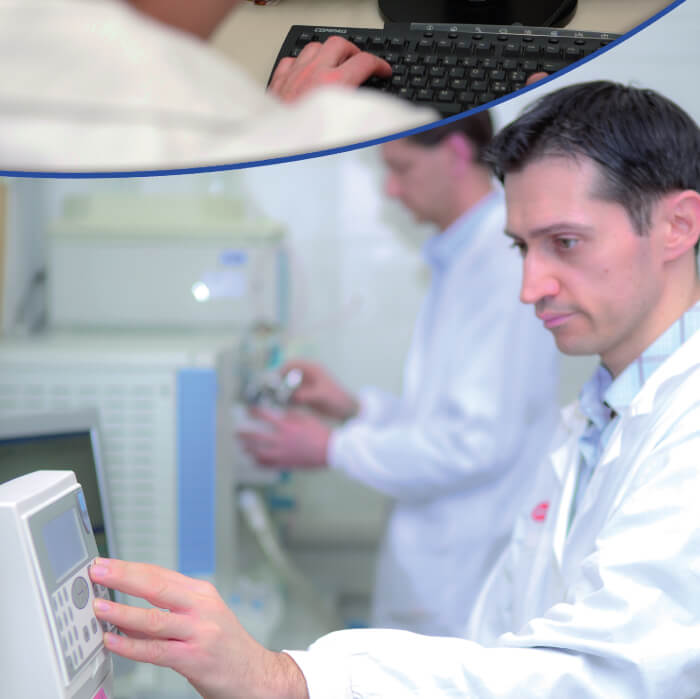My priorities would be affordability and accessibility. State-of-the-art MS instruments offer substantial advantages for understanding biological diseases and translating advances towards solving human health crises. Discoveries in this realm are made possible by large-scale proteomics, metabolomics, and lipidomics efforts, which rely heavily on MS instrumentation. Though there are many laboratories that have access to high-end MS instrumentation there are many more that do not because of the cost. I wish there were more centralized facilities that researchers could take advantage of to conduct high-throughput MS analyses at substantially reduced costs. Even better, if we can figure out how to manufacture these instruments in a way that reduces purchase costs, I envision many more laboratories worldwide with high-end MS instruments just steps away from their lab doors.
Renã Robinson, Associate Professor of Chemistry and Neurology, Vanderbilt University, Nashville, Tennessee, USA.

From the perspective of using MS in the clinic, there are two developments I’d like to see:
1. With two-minute analysis (no chromatography), flow-injection MS/MS analysis has made population screening possible – with the benefits there for all the world to see in newborn screening. What I would like to see perfected is more rapid chromatographic separation or an “on the fly” separation that doesn’t have to be “perfect” like capillary chromatography or micro LC analysis but rather a gasphase or simpler flow-injection system (perhaps with a little chromatography or separation behavior). Then I can let MS/MS do the rest. Time matters in my business.
2. Much more flexible post-analytical software. I helped develop, at least conceptually, the software needed for two vendors in newborn screening and have used both. Still, they are a challenge to custom design. There seems to me to be a huge opportunity to develop a software application that can be customized to your needs – and yet can work across platforms. Very large enterprise programs exist, but I want something more user friendly – what Microsoft PowerPoint is to presentations or Adobe Photoshop is to photos. Vendors are often slow to meet your needs; software experts are expensive and often either don’t finish the job or don’t provide support a few years down the road.
Donald Chace, Chief Scientific Officer, Medolac, Swansea, Massachusetts, USA.

One issue with mass spectrometric analysis of small molecules is the source-induced fragmentation that causes confusion in the identification of unknowns for global metabolomics. My ideal instrument would eliminate all source-induced fragmentation, while at the same time reducing ion suppression to create a near-uniform ionization process.
Timothy Garrett, Associate Professor, Department of Pathology, Immunology and Laboratory Medicine, University of Florida College of Medicine, Gainesville, USA.

1. For untargeted metabolomics: improvements in sensitivity for low-molecular-weight ions on QTOF systems to make it possible to carry out high-quality, data-dependant acquisition. Plus, improvements in dynamic range, to reduce the loss of lower abundant metabolites and saturation of those at very high
concentrations.
2. For imaging, there are lots of areas for improvement, including speed of acquisition, laser resolution, and better software for overlaying multiple image types (MS, histology, and so on).
3. Other “wishes” are to develop approaches to better deconvolve multiplexed MS/MS spectra acquired using MSE, SWATH, AIF, and msxDIA technologies.
Caroline Johnson (Assistant Professor, pictured), Yuping Cai (Postdoc) and Alvaro Santos-Neto (visiting Professor), Yale School of Public Health, New Haven, Connecticut, USA.

@BiswapriyaMisra Advancements exclusively amenable for absolute quantification. All data formats open source. Standardized workflows across vendors for special applications (lipidomics, exposomics).
@ProteinMassSpec High res ion mobility separation.
@FasciottiMaira The development of GC-IRMS systems!
@manohar_dange LC-independent MS… with current resolution and sensitivity.
@ProteinMassSpec @Shimadzu has a high mass MALDI detector. But everyone needs to start improving intact protein resolution on MALDI. No real advancement in years. Why can’t I resolve intact mAb glycoforms... come on!
@Putuma MS analyzers stripped down to minimize analytical variability in the clinic or point of care. Portable, handheld or adaptable to the operation room.
@TheRealGMW Faster ETD scan acquisition.
@rbharathkumar91 More ions into mass spec and sensitive.
→ @techpeasant The perennial desire! Also, front optics which never get dirty.
→ @alan_jarmusch Open software that is simple to use. Free exchange and deposition of MS data. Improvement and expansion of MS2 databases (e.g. @GNPS_UCSD) for identification of chemicals in samples in untargeted experiments. Portable instrumentation with MS2 capability, e.g. @AstonlabsPurdue.
@SimonaFrancese A decent PMF software to come with the instrument.
@MohRefai Pocket size mass spec.
@kiddingyou Hardware is good enough for me now. I wish there was more intelligent instrument control and definitely downstream data analysis. It’s a Wild West world out there in terms of software.
→ @olgavitek There is a lot of recent progress in open-source software and algorithms, though.
→ @ProteinMassSpec We should all post our go-to open source workflow! #opensource #massspec.
→ @manohar_dange Yes, one also learns a lot from using an open source platform... we can actually see the steps of processing in the code. Very useful for beginners. I enjoyed it.
Want to join the conversation? Follow us @tAnaSci
My wishes for the next generation of mass spectrometers would be:
1. Single molecule detection.
2. Unlimited mass range, and sensitivity in the high mass range that rivals the sensitivity in the low mass range.
Benjamin A. Garcia, Professor, University of Pennsylvania, Philadelphia, USA.

My comments are related to the use of MS in research that involves small- and medium-size molecules. The combination of full automatization, miniaturization and portability would have an important impact on field research, particularly in ecological chemistry and biological studies. For example, studies on pollination and on plant–plant or plant–insect interactions require the detection and identification of trace amounts of substances that are released in a time-dependent manner. Beyond on-the-spot work with individual instruments, a network of autonomous, Wi-Fi-connected mass spectrometers performing real-time monitoring has many applications in biological studies, but also in environmental control and for security purposes.
A field that requires substantial advance is the connection of fully automated monitoring and sample preparation with MS. Highly selective, specific probes capable of scanning, sweeping or somehow covering a surface, while filtering molecules and performing atmospheric pressure ionization, would facilitate many analyses.
Substance identification would be enhanced by computational algorithms that combine the large amount of existing knowledge about the spectra of known molecules, with the physical and chemical principles that govern fragmentation patterns to make reliable predictions about mass spectrum–structure relationships.
Looking further into the future, perhaps a combination of specially designed ion traps may allow us to obtain the proton NMR spectra of molecular ions and fragments. This would greatly facilitate structural identification, especially in the case of different types of isomeric structures.
Elena Stashenko, Director, Research Center for Biomolecules - CIBIMOL Research Center of Excellence, CENIVAM Universidad Industrial de Santander Bucaramanga, Colombia.

1. A new generation of MS instruments that are miniaturized and portable, totally connected to the web/cloud, and affordable as a field screening tool to solve food quality, authenticity and safety issues.
2. MS instruments that can provide both low- and high-resolution solutions depending on the specific need (or can be integrated with different modules in a sort of “progressive investment”) – whether for a targeted quantitation of a single analyte in a simple matrix or a metabolomics approach in a complex one.
3. Significant improvements in post-analytical software for handling and elaboration of big data, in terms of flexibility and easy-of-use, linked to the new frontiers of artificial intelligence and automation.
4. Evolution of reliable software dedicated to ambient ionization MS interfaces, and improved quantitative potentialities of those techniques for direct measurements on food, without sample preparation.
Michele Suman, Food Safety and Authenticity Research Manager, Barilla, Parma, Italy.

In art analysis, we usually only have one chance to analyze a single microsample that can contain mineral pigments, proteins, polysaccharides, lipids and other polymers, such as polyterpenes. Our goal is to identify all of the components but also to characterize degradation caused by age or interactions with other components within the sample, so we need highly sensitive, versatile, robust, and affordable instrumentation. My “most wanted” advances in mass spectrometry are:
1. Increased sensitivity for trace level analysis.
2. Very high resolution/mass accuracy combined with high scan speed (toward FT-ICR resolution, but faster).
3. High versatility to enable easy shifting between analyses of different kinds of molecules in a single micro-sample.
4. Improved ion mobility for high-resolution conformational analysis plus more robust MS/MS.
5. Indirectly linked to MS: more integrated and robust data processing tools for analysis other than bottom up proteomics.
6. More options for high spatial resolution imaging capabilities for MALDI with high sensitivity.
7. Portable MS that can reliably analyze low and medium molecular weight molecules.
8. Lower purchase, operation and maintenance costs.
Julie Arslanoglu, Research Scientist, The Metropolitan Museum of Art, New York, USA.

What do YOU think? Tell us about your mass spectrometry dreams – email charlotte.barker@texerepublishing.com




